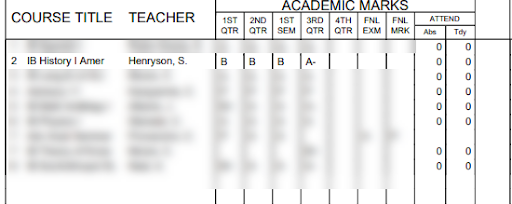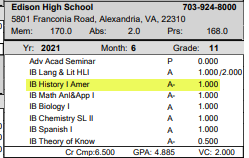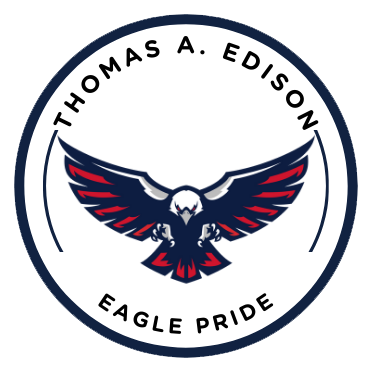Standards Based Grading at Edison
Presentation from Parent Info Night 05/11/2022
Video from presentation
Research Behind Standards Based Grading
Padlet questions from parents
What is Standards-based Grading
● A grading and reporting practice to communicate student progress on course standards
● Only grades directly assessing a standard are weighted.
● Students are given ungraded practice on the standard prior to assessment.
● The highest level of learning is recorded.
● Informs all stakeholders of the essential standards students learn in each subject area at a particular grade level.
● Designed to give students, teachers, administrators, and parents/guardians a better understanding of strengths and areas of growth for that student, so they may offer support.
Learning vs. Grades
Shifting towards standards/skills-based grading changes the conversation between the teacher and students and their families. We can now speak in terms of skill development rather than task completion.
Standards-based grading can empower students to take control of their own grades because there are clearly defined learning goals and a clear path towards growth, rather than a focus on deficiency.
Plan for 2022-23 School Year
FCPS Grading Practices
Below are FCPS grading practices Edison is ensuring all classrooms are adopting
● Elimination of work habits in grade
● Attendance not a part of the grade
● 50% lowest grade on 100% pt. scale
● Rolling grade book
Standards and Skills
WHAT:
Standards & Skills replace the traditional assignment or task-oriented grading.
WHY:
● Research-based best practices
● Align with the use of a Rolling Gradebook
● Create transparency and clarity for essential course knowledge, skills, and competencies.
● Create opportunities for Deeper Learning focused on the learning that matters the most to us and our students.
Thomas A. Edison Common Purpose for Grading
At Edison High School, we believe in a grading practice which fosters a growth mindset; therefore, through standards-based grading, we utilize a 4.0 grade scale in conjunction with a rolling gradebook. This practice informs all stakeholders of the essential standards students learn in each subject area at a particular grade level. It is designed to give students, teachers, administrators, and parents/guardians a better understanding of strengths and areas of growth for that student, so they may offer support.
Edison High School Grading Scale
|
Definition |
Communication |
Grade Range |
|
|
Advanced |
Consistent demonstration of applying, recognizing, and transferring the standard |
“I can apply my knowledge in different situations or from different perspectives.” “I can do this well enough to teach others.” |
A 3.8 - 4.0 |
|
A- 3.4 - 3.7 |
|||
|
Proficient |
Demonstrates understanding of the standard with few errors |
“I can complete all of my work independently, but I might make minor mistakes.” |
B+ 3.1 - 3.3 |
|
B 2.8 - 3.0 |
|||
|
B- 2.4 - 2.7 |
|||
|
Competent |
Partial understanding or demonstration of the standard; requires some additional support |
“I can complete some of my work.” “I am not confident that I am doing it right without help.” “I am in the process of learning to do this, but need more practice or help.” |
C+ 2.1 - 2.3 |
|
C 1.8 - 2.0 |
|||
|
C- 1.4 - 1.7 |
|||
|
Limited |
Minimal demonstration of understanding of the standard; unable to demonstrate understanding without significant support |
“I cannot complete any of my work without help.” |
D+ 1.1 - 1.3 |
|
D 0.8 - 1.0 |
|||
|
Insufficient Evidence |
No evidence of understanding yet |
“I turned in completed work, but my work does not show that I understand.” |
F 0.1-0.7 |
|
F 0.0 |
|||
|
“I did not turn in any work.” |
Rolling Gradebook
A standards/skills-based rolling gradebook is a gradebook that reflects the 8-12 Essential Skills for the course and reflects individual students’ proficiency level for each skill over the course of the year.
Grades on individual standards or skills are replaced or “roll” as students are provided opportunities throughout the year to increase their learning and improve their proficiency.
- A cumulative documentation of learning
- Unlike quarterly gradebooks, a rolling gradebook documents learning on an ongoing basis throughout the year.
- This grading and reporting practice allows for increased opportunities for students to show their highest level of learning on individual standards.
Comparison: Traditional vs. Rolling Gradebook
| Traditional: | Rolling: |
|
|
|
|
|
|
Retakes or Reassessments
Spiral Review - after teaching a foundational concept or skill, students continue to practice it regularly throughout the year in order to demonstrate retention of learning
Mandated Retake - an instructional and assessment policy which supports students whose work falls below a minimum threshold of learning by requiring remediation followed by a retake/redo of the standard
Students will not retake everything:
- Sometimes there will not be a retake, but a new assignment in the future, with an opportunity to display understanding on the same standard (grade gets replaced)
- Students may have to complete practice work first to show understanding; homework does facilitate learning and a way to take risks with the content.
Purpose of Homework
Homework is an opportunity for teachers to give students individualized feedback on their learning at a given point in time. Work assigned as homework is considered practice, is formative in nature and ungraded. Homework can also consist of preparing and studying for assessments. When assigning homework/practice, Edison’s teachers consider the purpose and the quantity, ensuring that the type and amount is appropriate and differentiated for the intended learning. Homework should aim to prepare students for assessments, reinforce learning and serve as practice for the skills needed to understand the course standards.
What Will You See on the Report Card?
Report cards and transcripts will remain the same, showing the letter grade for each class.


Resources
- FCPS Secondary Reporting and Grading website: https://www.fcps.edu/academics/grading-and-reporting/secondary
- 100 pt vs. 4.0 Scale Video: https://youtu.be/adzARR3vjdk
- “Not Including Classwork and Homework (Formative Assessment) in the Grade”, Grading for Equity https://gradingforequity.org/2018/09/13/not-including-classwork-and-homework-formative-assessment-in-the-grade/
- “Should Homework Be Graded?” By Richard DuFour https://www.allthingsplc.info/blog/view/52/should-homework-be-graded
- “Teachers second-guess letter grades as they search for a fairer way”, Washington Post https://www.washingtonpost.com/education/2022/02/28/letter-grades-grading-a-f/
- Homework - What is it good for - European Commission https://eacea.ec.europa.eu/national-policies/eurydice/content/homework-what-it-good_is
